
This massive Nintendo Switch alternative lets you play PC games on the go

When I play visually rich PC games like God of War and Star Wars Jedi: Fallen Order on the Steam Deck’s small screen, I feel like I’m getting a taste of a very exciting future. Valve’s new handheld successfully makes PC gaming portable, packing enough power to play the tens of thousands of games on Steam at console-like quality while also doubling as a full-on computer. It’s essentially a Nintendo Switch on steroids — and not just because it’s huge.
Now, while the Steam Deck does a great job letting you play PC games on the go (and is a lot cheaper than a gaming laptop), it’s very much a first-generation product. It’s pretty bulky, it has some occasional performance hiccups and its battery life isn’t always great. It also isn’t guaranteed to play every Steam game out there, with some notable titles that are fully incompatible.
Should you take the risk of being an early adopter or wait for Steam Deck’s kinks to be worked out? Here’s what I think after doing lots of gaming (and even a bit of working) on Valve’s innovative handheld.
PC gaming on the go
The Steam Deck is a powerful portable gaming PC that can run high-end titles at console-like quality.
The who, what and how
Who it’s for: The Steam Deck is ideal for two groups of people: PC gamers who own lots of games on Steam and want a convenient way to play them on the go, and folks looking to get into PC gaming without shelling out $1,000 or more on a gaming PC.
What you need to know: The Steam Deck is a handheld gaming PC designed to play the tens of thousands of games on the Steam marketplace at fairly respectable settings. It’s also a full-on Linux computer, with a desktop mode that you can use to run apps and browse the web. It delivers a pretty great portable PC gaming experience, though its battery life isn’t very good for demanding titles, and not all games on Steam are optimized or compatible.
How it compares: Valve’s portable gaming rig is much larger and more powerful than the Nintendo Switch, packing a custom AMD processor that allows it to run graphically rich games at settings comparable to what you’d see on a PS4, Xbox One or cheap gaming rig. Its battery life generally isn’t as long as the Switch’s based on our testing, likely because the Steam Deck draws more power and can run higher-end games. And while not all Steam games are fully optimized for Steam Deck just yet, it has the advantage of having a larger library than just about any console — just note that it’s not explicitly designed for non-Steam games, such as the ones you’ll find on Xbox Game Pass and the Epic Games Store.
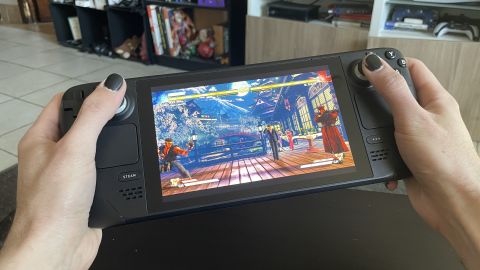
The Steam Deck is just about the biggest portable gaming machine I’ve ever gotten my hands on — and I’ve been around since the OG Game Boy. The nearly 12-inch-wide handheld makes even the standard Nintendo Switch feel tiny, and will demand a decent amount of space in your backpack. Fortunately, the Steam Deck comes with a free carrying case, which has a sturdy outer shell and a convenient handle that makes it easy to carry the system around. And aside from a few quirks, Valve’s plus-size portable feels largely great to use for long periods of time.
It’s surprisingly light at about 1.5 pounds and features substantial ergonomic grips on the left and right sides that feel more like an actual controller than the flat Joy-Cons that attach to the Switch. The handheld blends a familiar Xbox-style button layout with some features from Valve’s Steam Controller — if you’re one of the dozens of people who remember that thing — with all of your requisite buttons, thumbsticks and shoulder buttons as well as two unique trackpads that can mimic everything from joysticks to mouse inputs.
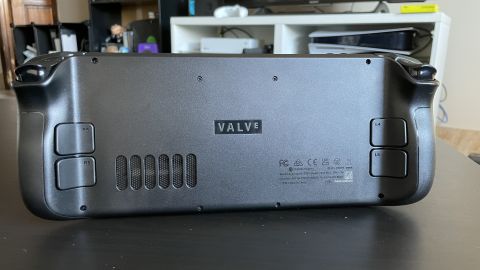
I especially love that the Steam Deck has four programmable buttons on the rear grips, which were very handy for jumping and dashing around in Doom Eternal without having to take my thumbs off the sticks. The handheld even has Switch-esque gyroscope controls, which made it easy to precisely aim in Counter-Strike: Global Offensive by simply moving the system around. And while most games felt great out of the box, you can fully remap the Deck’s controls on a title-by-title basis, which is great for accessibility as well as simply being able to play exactly how you want to.
Valve’s portable PC was mostly comfortable to game on for extended periods, though I do have some gripes. As someone who plays lots of fighting games, the directional pad — which is awkwardly placed right next to the left analog stick — caused me to miss a lot of my usual combos in games like Street Fighter V and Mortal Kombat 11. And while the Steam Deck’s layout is pretty intuitive for traditional action games and shooters, I did find my hands cramping up during intense God of War encounters that required me to use the shoulder buttons often. I also found the Steam button, which you use for accessing the main menu, to be a little hard to reach with my left thumb.
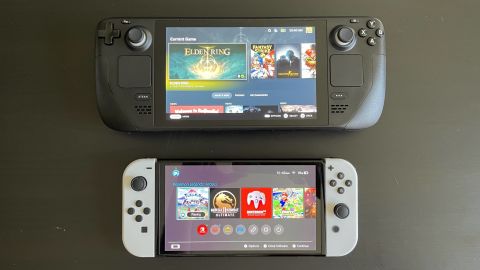
The Steam Deck is pretty Switch-like in terms of ports and system controls, with a USB-C port (for both charging and accessories), a headphone jack, a power button and volume buttons up top as well as a microSD card slot on the bottom. These all work fine, though there’s no cover for the microSD card slot, and I found it somewhat difficult to pop my memory card in and out.
There’s no kickstand or included dock for playing on a TV like you’ll get on the Switch, though Valve is releasing its own Docking Station later this year for a yet-to-be-announced price. You can also connect it to your own USB-C hub if you want to play on a monitor (up to 8K displays are supported) or connect other accessories.

The Steam Deck delivers big where it matters most, offering strikingly good performance for a device that you can easily take on a train or plane. Valve’s portable ran modern PC games at a fidelity that’s largely comparable to what you’d get on a PS4, Xbox One or cheap gaming laptop — and certainly better than what you’ll get from the Switch.
Demanding titles like God of War, Star Wars Jedi: Fallen Order and Elden Ring looked crisp and ran smoothly, turning in frame rates of up to 60 frames per second (which we consider ideal) at medium settings and closer to 30 to 40 frames per second (which is still highly playable) with the graphics cranked all the way up. The vast majority of titles I played ran at close to 60 frames per second out of the box, though I found myself toning down the graphics on certain games to get the level of smoothness I wanted.
It felt great to play largely uncompromised versions of these visually rich PC games on a handheld, especially when similar third-party blockbusters are seriously scaled back on the less powerful Switch. It’s worth noting that while the Steam Deck consistently stayed cool, its fans got pretty loud when playing more intensive titles. And while there’s no big surprise here, less intensive indie games like OlliOlli World and The Messenger looked and felt great.
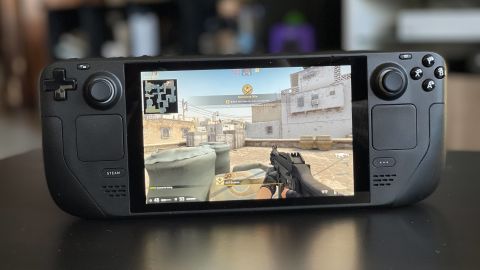
Games generally looked great on the Steam Deck’s 7-inch, 1200 x 800 display. Cartoony titles like OlliOlli World and Ultimate Marvel vs. Capcom 3 popped with color, and I noticed plenty of grisly details in more cinematic fare like God of War and Doom Eternal. However, I wish the screen could get just a bit brighter at full blast, and the system’s overall color and contrast pales in comparison to the extra-vibrant Switch OLED screen. The Deck’s dual front-facing speakers were decently loud and clear for a handheld, making everything from lightsaber slashes to Street Fighter uppercuts sound crisp and punchy.
To get a more objective sense of how the Steam Deck compares to an actual gaming rig, I ran it through the same Shadow of the Tomb Raider benchmark that we use to help determine the best gaming PCs and best gaming laptops. Valve’s portable PC handled the cinematic action game at 49 frames per second at low settings and 37 frames per second with the visuals maxed out — that’s a far cry from the 90 to 100 frames per second we got on most gaming laptops, but it’s still perfectly playable, especially for on-the-go gaming.
That being said, I did run into a few performance hiccups on Steam Deck, including a strange crash that would occur every time I tried to hop into an online battle in Mortal Kombat 11. There were also a few instances of games not launching properly and general main menu sluggishness, which were mostly fixable with a quick reset. Fortunately, Valve has been pushing updates out pretty frequently to address performance issues, which is something I hope to see continue.
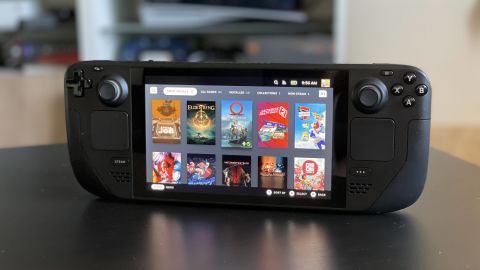
While Steam Deck worked well with nearly all of the 20-plus games I tested, it isn’t guaranteed to run every title available on Steam properly. The good news is that Valve’s labeling system makes it easy to get an idea of how well a title might work on your Deck. The bad news is that the number of Steam Deck-optimized games is fairly small for now.
Whether you’re browsing your personal library or shopping for new games in the Steam store, you’ll see one of four labels on any given title:
- Verified (or Great on Deck): Guaranteed to work well with Steam Deck’s built-in controls.
- Playable: Guaranteed to work on Steam Deck, but may require some extra effort (such as using an on-screen keyboard or zooming in on small text).
- Untested: Not guaranteed to work on Steam Deck.
- Unsupported: Currently unplayable on Steam Deck.
Out of the 100 or so titles in my Steam library, 11 of them are currently marked “Great on Deck,” with 20 total being guaranteed as “Playable.” Pretty much every Untested game that I tried (including Street Fighter V, Doom Eternal, Mortal Kombat 11 and Resident Evil 3) worked great, so you shouldn’t have much trouble with unconfirmed titles. But I was disappointed to find that Halo Infinite — my current PC game of choice — is completely unplayable on Deck as of now.
There are some other notable titles that are currently unsupported, including Destiny 2, Lost Ark, Tom Clancy’s Rainbow Six Siege and Phantasy Star Online 2 New Genesis. The overall number of incompatible titles is relatively small, and there are already more than 500 fully optimized titles out there, including hits like Elden Ring, The Witcher 3, Hades, Stardew Valley and Horizon Zero Dawn. But I would definitely recommend checking the Steam store on desktop before dropping a few hundred bucks on a system that might not play your favorite game.
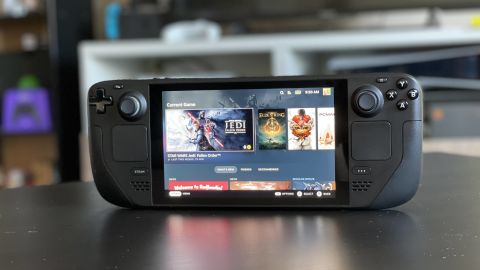
Once you boot up your Deck and log in to your Steam account, you’ll be treated to a clean, console-like SteamOS interface that makes it easy to launch games, keep tabs on your friends and quickly adjust settings. The system’s virtual on-screen keyboard was mostly reliable for messaging my Steam buddies and browsing the store (and delivers some nice haptic feedback), though I had to apply a good amount of force for it to register my inputs.
There are a lot of small software touches I really appreciate here, including an optional performance overlay that lets you see things like CPU usage, frame rate and estimated battery life while playing a game. Steam Deck also supports Remote Play for streaming a game from your PC to your Deck without having to download it, which let me mash away in Marvel vs. Capcom 3 with minimal latency.
But the Steam Deck isn’t just a portable gaming machine — it’s also a full-on computer. That means that I was able to connect an Xbox controller via USB-C when I wanted more precision in Tekken 7, pair a Bluetooth mouse and keyboard to more easily navigate the store and hook up my AirPods Pro to better hear my enemies coming in Doom. And once you switch to Desktop mode, the Steam Deck becomes a straight-up PC that you can use however you see fit.
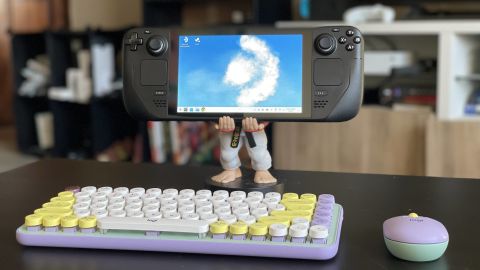
The Steam Deck’s Desktop mode runs on a custom version of Linux that looks and feels a lot like Windows at first glance but has lots of unique quirks. As a Linux newbie, I had a hard time figuring out how to manually download apps from the web, though there’s a handy built-in storefront that makes it easy to get programs like Spotify or Discord up and running. I wouldn’t recommend sending Slack messages or working in Google Docs on a 7-inch screen, but I was absolutely able to do those things on my Steam Deck.
If you’d rather not bother with Desktop mode, Valve includes a handy shortcut to download Google Chrome in the Steam Deck’s library menu so that you can at least browse the web and watch Netflix. It’s worth noting that Valve’s handheld isn’t quite ready for cloud gaming just yet — while I was able to launch Xbox Game Pass and Amazon Luna games via Chrome, the browser didn’t recognize the system’s controller inputs. Valve is aware of this issue and is planning on releasing a fix in the near future.
Beyond that, the Steam Deck’s capabilities as a PC are only as limited as your imagination and technical know-how. You can install Windows on it (though we’d recommend holding off until official drivers are released), which gives you the freedom to download non-Steam marketplaces, such as the Xbox app, Origin and Epic Games Store, the latter of which you’d need to play popular titles like Fortnite.
As someone who owns a fair amount of PC games on these stores, I would love it if there were a simpler way to bring them to Steam Deck. That said, I appreciate how open-ended Valve’s portable gaming computer is, and have already enjoyed seeing some of the cool and ridiculous things people are doing with it.
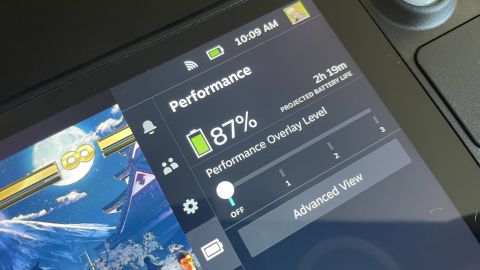
If you’re expecting the Steam Deck to last through a long flight’s worth of visually immersive gaming, you’ll probably be disappointed. Valve’s handheld is rated for two to eight hours of battery life depending on the title, and I found myself reaching the lower end of that scale when playing graphically demanding games. Titles such as Elden Ring and Star Wars Jedi: Fallen Order were especially hard on the system’s 40Wh battery, draining it in around an hour and a half when playing at full brightness. You’ll definitely want to keep a portable charger handy when using this thing on the road.
But while the Steam Deck won’t always last super long, I love the fact that Valve’s handheld can provide a detailed on-screen battery estimate that will update in real time based on what you’re playing. For example, when switching from a power-sucking game like Metal Gear Solid V to the more lightweight OlliOlli World, I immediately saw the battery projection jump from a couple of hours to about four. And when you’re charging, the system will give you an estimate of how long you have to go before it’s at 100%. These are really useful touches that at least let you plan out your gaming time.
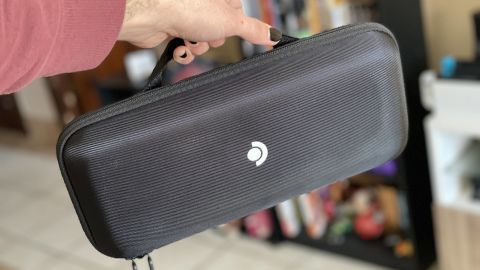
The Steam Deck comes in three storage options — $399 for 64GB, $549 for 256GB and $649 for 512GB — and I would strongly recommend springing for one of the higher-end models if you can.
Not only does the starting model barely have space for a single triple-A game, it also uses slower eMMC storage, meaning games won’t load as fast as they will on the 256GB and 512GB models that feature speedy NVMe solid-state drives (SSDs). Given the fact that some PC games demand upward of 100GB, even my 256GB model filled up frequently, forcing me to constantly delete titles to make room for new ones.
Fortunately, you can expand your Steam Deck’s storage with a microSD card, and they’re generally pretty cheap; this popular SanDisk option will get you 256GB of storage for about $38. The 64GB card I popped into my Steam Deck ran titles such as Metal Gear Solid V and Jet Set Radio just fine. Just keep in mind that you won’t get the same fast load times as you will from the system’s SSD.
And if you don’t mind having a big brick connected to your Steam Deck, you can also connect an external hard drive via the USB-C port. But I’d still recommend going with at least the 256GB for its fast-loading SSD, and the 512GB model if you don’t want to depend as heavily on external storage.
It’s worth noting that Steam Deck availability is currently limited, and you’ll have to make a reservation (complete with a $5 deposit) on the Steam website in order to get a chance to buy one. Once you have a reservation down and inventory becomes available, you’ll have 72 hours to make a purchase.
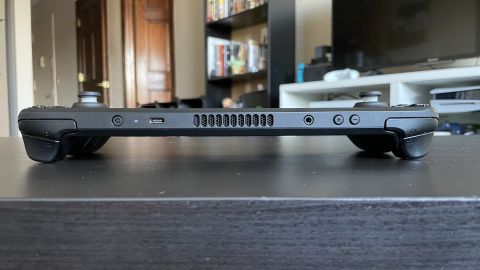
As someone who loves PC gaming but still prefers to play games on the couch (or on the go), the Steam Deck feels tailor-made for me. There’s something magical about being able to play power-hungry titles like Elden Ring and God of War on a handheld — at respectably high fidelity no less — and tinkerers will find a lot to love about its flexibility as a full-on Linux PC. While the Deck is more expensive than other handhelds, even the highest-end $649 model is cheaper than most gaming laptops, making it a solid entry point into PC gaming.
That being said, the Steam Deck’s underwhelming battery life, fairly bulky design and occasional bugs are indicative of a product that has plenty of room to grow. Given the way that similar handhelds have evolved, it’s easy to imagine a more compact, efficient successor arriving somewhere down the line. And while more than 500 games are already guaranteed to work well on the handheld, there are many more that aren’t, and those who want to be sure that their entire library will be supported may want to wait as Valve continues to optimize for the platform.
If all you want to do is play games on the go, the $199 Nintendo Switch Lite, $299 Nintendo Switch and $349 Nintendo Switch OLED will serve you just fine. They’re cheaper, have tons of great Nintendo exclusives and play many of the same indie and third-party games that you’ll find on Steam Deck. But if you’re looking to take your Steam library on the road or want access to just about the biggest game selection out there, the Steam Deck is a very good first attempt at portable PC gaming that could eventually become great.
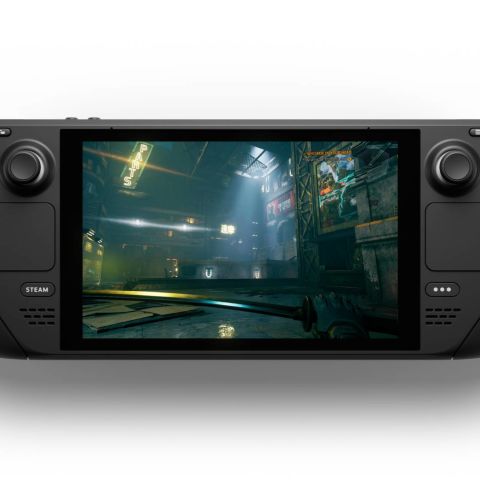 Steam Deck (64GB) |
 Steam Deck (256GB) |
 Steam Deck (512GB) |
|
|---|---|---|---|
| Processor | 4-core AMD Zen 2 | 4-core AMD Zen 2 | 4-core AMD Zen 2 |
| Graphics | AMD RDNA with 8 compute units | AMD RDNA with 8 compute units | AMD RDNA with 8 compute units |
| Memory | 16GB | 16GB | 16GB |
| Storage | 64GB eMMC | 256GB NVMe SSD | 512GB high-speed NVMe SSD |
| Display | 7-inch, 1280 x 800 IPS LCD touchscreen | 7-inch, 1280 x 800 IPS LCD touchscreen | 7-inch, 1280 x 800 IPS LCD touchscreen with anti-glare etched glass |
| Refresh rate | 60Hz | 60Hz | 60Hz |
| Ports | USB-C, microSD card slot, headphone jack | USB-C, microSD card slot, headphone jack | USB-C, microSD card slot, headphone jack |
| Battery life (rated) | 2 to 8 hours | 2 to 8 hours | 2 to 8 hours |
| Size | 11.7 x 4.6 x 1.9 inches | 11.7 x 4.6 x 1.9 inches | 11.7 x 4.6 x 1.9 inches |
| Weight | 1.47 pounds | 1.47 pounds | 1.47 pounds |
| Extras | Carrying case | Carrying case, exclusive Steam Community profile bundle | Exclusive carrying case, exclusive Steam Community profile bundle, exclusive virtual keyboard theme |
| Price | $399 | $529 | $649 |
Source: https://www.cnn.com/2022/03/04/cnn-underscored/valve-steam-deck-review/index.html?iid=CNNUnderscoredHPcontainer


















